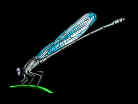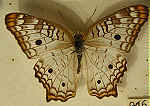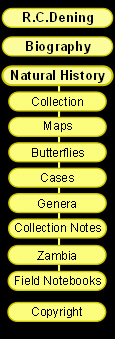The R.C. Dening Collection |
 |
Introduction to Zambian Butterflies
by R.C. Dening F.R.E.S.
A History of Butterfly Recording in Zambia
COLLECTORS |
| The volume of
literature on Zambian butterflies, at least over the past half-century, has inadequately
reflected the level of activity in collecting and recording. The earlier literature shows that activity started in the previous century, well before the country's boundaries had been demarcated. Richard Crawshay collected around Lake Mweru in the far north between June 1892 and January 1893, sending 71 species and forms (plus moths) to Sir Harry Johnston, the first administrator of Nyasaland (Butler, 1893). Shortly afterwards, Carson sent a collection from Fwambo near Lake Tanganyika, consisting of 18 species (plus moths), (Butler, 1895). The species in these lists are mostly recognisable in terms of our current *Checklist, although in some cases generic and specific names have changed. In the first decade of this century, F.Seiner recorded 42 species from Livingstone and the Upper Zambezi (Strand, 1909). However, the most important collector in the early years of this century was Sheffield Airey Neave, who was involved in two expeditions to what was then North East and North West Rhodesia, together with Katanga in the Belgian Congo. The first expedition, when Neave was naturalist to the Geodetic Survey, took place between 1904 and 1906; this covered the Eastern Province of modern Zambia, including much of the Luangwa Valley, through to Mkushi, Ndola and the Copperbelt, then back via Serenje. The second expedition, when Neave was Entomologist to the Katanga Medical Commission, occurred during 1907 and 1908. This started at Kabwe (railhead at Broken Hill), continued through the Copperbelt to Kansanshi near Solwezi; then travelled for a substantial period through Katanga, right across the Lubudi River near the Kalene Hill pedicle; then back via Serenje to Petauke and Chipata. He then went north again to Chinsali, the Chambeshi River, Lake Bangweulu, Luwingu, Mporokoso, Lake Tanganyika, and back via Mpika to Chipata. A copy of Neave's map can be found in Neave, 1910. Altogether Neave collected some 25 000 specimens, and listed 450 species, of which 367 came from Zambia, a remarkable checklist for so early in our history. He also gave descriptions of the main habitats.From 1902 to 1905, Harold Cookson collected in Katanga, sending his specimens out via the new Rhodesian railhead north of Ndola, so that for many years there was confusion as to whether any of them had been collected in Zambia. It was not until White queried this point in the early 1950's, that Cookson published a correction to Druce's 1905 descriptions of his specimens, pointing out that all had actually been collected in Katanga (Cookson, 1954). Between 1913 and 1918, Hereward Dollman collected 22 species and subspecies, first at Mumbwa in 1913, but mainly at Solwezi and around the Lukanga River in Ndola Rural District. On his death, the collection was presented to the BMNH and was described by Norman Riley (Riley, 1921). Although Riley refers to "the much fuller and more interesting notes contained in Dollman's numerous diaries, and (the figures of) larvae of which he made so many extraordinarily good drawings", it seems that his intention to publish these at a later date was not pursued. After the end of the First World War, there is no record of any collections until 1951, when the late C.M.N. White M.B.E. and R.C.Dening independently started to collect. Charles White, initially an ornithologist, (and subsequently a notable African linguist), had joined the Territory's administration just before the Second World War, with the private intention of studying African Birds. In due course, he and Winterbottom wrote three successive Checklists of the Birds of Northern Rhodesia, then needing a change, he turned his attention to the butterflies. Dening, an enthusiastic naturalist in his boyhood, and amazed by the diversity of insect and plant life, began a study of the butterfly fauna of the Mwinilunga District, where he was stationed for five years. In those days, the only means of identification for most tropical species was Seitz (Seitz, 1925), of which White had a copy. The group was joined by Kit Cottrell (later Dr.C.B.Cottrell), then a student, who collected and conducted field studies during wide-ranging tours with his father, the Territory's Director of Education. From an early stage, White prepared a series of draft Checklists, based on earlier literature, his own records, and those of Dening and Cottrell. These were not published, since too many species could not at that time be identified with certainty, particularly in difficult genera such as Euphaedra, Neptis and Ypthima, not to mention the Lycaenidae. It was feared that if the lists became widely distributed, they would acquire an unjustified authority. But by 1956, the Checklist amounted to some 700 species, and White published the sections on Papilionidae and Pieridae (White, 1956). The Checklist continued to be maintained in draft form by White, Dening and Cottrell well into the 1960's, as new information came to hand. For instance, Cottrell and Loveridge recorded 89 species from the Cryptosepalum forests of Mwinilunga (Cottrell & Loveridge, 1966). Cottrell also worked on Zambian Aslauga species in support of his monograph on the genus (Cottrell, 1981).Meanwhile Dr.Elliot Pinhey, Curator of Entomology at the National Museum, Bulawayo, took an increasing interest in the Zambian fauna (Pinhey & Loe, 1977), assisting with identifications and making a number of expeditions, particularly to Mwinilunga. (Pinhey was also a distinguished authority on African dragonflies and Southern African Moths, with a major work on the latter and separate volumes on Saturniidae and Sphingidae). B.Barton-Eckett, in 1963/5, listed 20 species of Charaxes, 64 Lycaenids and 40 Hesperiids near Kafue, from Geoffrey Wedekind's Mswebe Tobacco Farm on the Big Concession in North Mumbwa, the type locality of Charaxes cithaeron joanae (personal communication). In 1968, two new enthusiasts appeared on the scene, Malcolm N.Mitchell and Frank Schofield, collecting for about six years in all the more noteworthy habitats. Mitchell was also involved in captive breeding and genitalia studies of difficult groups, and wrote a Checklist of the Zambian Sphingid moths (Mitchell, 1973). His collection and slides are still extant, but a number of other collectors who were also active in the 1960's can no longer be traced. From the late 1960s, Alan Heath collected extensively on the Copperbelt and in the northwest, also making ground breaking expeditions to the Mafinga and Makutu Mts. He continued up-dating the Checklist, leading to his 1982 unpublished provisional listing. In this he collaborated with Dr.Stewart Fisher, (a descendant of Dr.Walter Fisher, who founded the Kalene Hill Mission, Ikelenge in the early years of this century), and later with Mike Newport who had commenced collecting on the Copperbelt in 1977.Heath left Zambia in 1982 and moved to Bulawayo where he met Dr. David Hancock, who was at that time the Curator of Entomology at the National Museum, Bulawayo. Hancock reviewed Heath's collection and Checklist in the light of the latest literature and produced an updated species listing, again unpublished. During the period up to 1985 Newport continued to collect on the Copperbelt and contribute records to the Checklist. He concentrated particularly on the South Mutundu River area near Mufulira, a bountiful area of Brachystegia woodland and riverine forest that yielded many new records, the most notable being Charaxes murphyi. At the time of writing Newport still obtains material from the northwest and the Copperbelt via his Zambian collectors, the material constantly adding distribution records and flight period information to the Checklist. Other collectors were active in the 1980's and have contributed records such as C.J.T.Blease, Alan J.Gardiner and Ray Murphy; unfortunately at the time of preparation of this publication the latter's extensive collection was unavailable for review. Over the years, residents and entomological visitors to Zambia have collected in many places and added species to the list or contributed to the literature, notably Ivan Bampton, Mike Bingham, Steve Collins, the Hennings, Reinier Terblanche, Alex Kapulile and Felix Kayombo.
|
 |
SOURCES OF BUTTERFLY MATERIAL FROM ZAMBIA |
| Organisations:
Private Collections:
* This introduction to Zambian butterlies was originally intended as an introduction to a Zambian Checklist being published as a book.
|
Continue to
